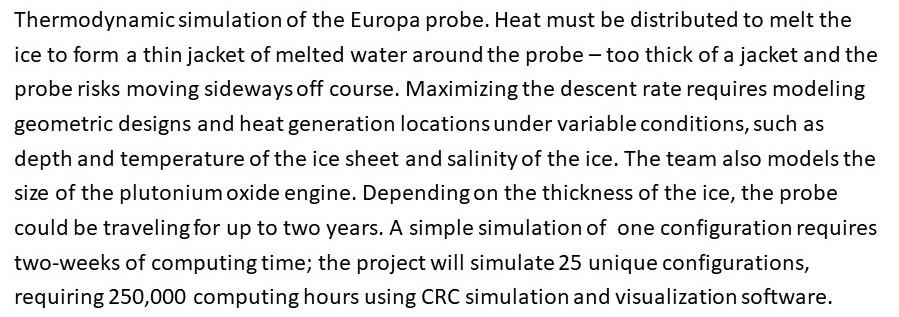Searching for life under Europa’s ice

Note the brown cracks in the surface, thought to be
frozen salt water,
Is there life beyond Earth? It is the weightiest question in space exploration. In 50 years of human probing, no moon, planet, or asteroid in the solar system has shown incontrovertible evidence of biological life, not even Mars, the perennial favorite candidate.
Orbiting Jupiter almost 400 million miles from Earth is the moon Europa. Europa carries several distinctions – among them being the smoothest and most reflective object in the solar system. Ice covers the entire surface, which shows few craters or elevations. Estimates of the thickness of the ice vary widely, from three kilometers to over 50.
Cracks in the surface point to the ice being in motion. The cracks are filled with a brown substance whose color matches salt samples bathed in the lab with Jupiter-intensity doses of radiation. Spectroscopic observations of Europa using the Hubble Space Telescope match the spectrum of the irradiated salts. The ice sheet is almost certainly composed at least partly of saltwater. The Galileo Jupiter probe and Hubble have detected plumes of water vapor erupting through Europa’s ice sheet.
What’s under the ice? If a saltwater ocean, Europa possesses the essential ingredient of biological life. NASA plans to explore that ocean – and thanks to Center for Research Computing collaborator Matthew Barry and his team, the University of Pittsburgh is an integral partner in one of the most ambitious and potentially consequential space missions since the Apollo program.
NASA plans two missions to Europa in the next decade. Europa Clipper will orbit Jupiter and fly by Europa carrying out several tests, including measuring the thickness of the ice sheet using ice-penetrating radar, and hopefully sampling a plume of water vapor.
That mission is scheduled for 2025. After studying data from Clipper, NASA plans to eventually send a physical lander with a probe that will tunnel through the ice to the anticipated sea. Designs for the lander and probe are in the early stages. Barry and his team model the thermodynamics of the probe – called a cryobot – that will descend slowly through the ice sheet powered by a plutonium carbide engine producing enough heat to melt the ice.
“Think of a giant hot aluminum bullet,” explains Barry, Pitt assistant professor of mechanical engineering and materials science.
Barry’s team works closely with NASA’s Jet Propulsion Laboratory (JPL). The relationship came about in an unusual way. Undergraduates in Barry’s lab – Juliana Said, Laura Fulton, and Joanna Rivero – presented at the International Conference on Thermoelectrics in 2017 on radiation heat transfer modeling, device modeling, and optimization algorithms. After the presentation, JPL project manager Bill Nesmith approached the three and invited Barry’s team to join the Europa project.
"I was in disbelief that a program element manager at NASA JPL was inviting Pitt students to join a project that was to search for extraterrestrial life," says Barry.
Barry’s team creates thermodynamic simulations of the probe. Heat must be distributed to melt the ice to form a thin jacket of melted water around the probe – too thick of a jacket and the probe risks moving sideways off course. Maximizing the descent rate requires modeling geometric designs and heat generation locations under variable conditions, such as depth and temperature of the ice sheet and salinity of the ice. The team also models the size of the plutonium oxide engine. Depending on the thickness of the ice, the probe could be traveling for up to two years. A simple simulation of one configuration requires two-weeks of computing time; the project will simulate 25 unique configurations, requiring 250,000 computing hours using CRC simulation and visualization software.

“For students, this project calls on everything,” Barry explains. “For every aspect of the probe, we are working with a combination of thermodynamics, physics, and fluid mechanics.”
Bill Nesmith explains the importance of working with CRC.
“The Europa team has a compact core staff and we don’t have the computing power. CRC has the software packages we need, and Barry’s team has the modeling expertise. Partnering with universities frees us up, but also develops the future workforce. We have weekly teleconferences with the Pitt team, and we’re learning things through their thermodynamic modeling that affect the rest of the entire system.”
JPL has been impressed with the capabilities of the CRC resources available to Barry’s team, and Barry is grateful. “Without CRC, it wouldn’t have happened.”
Once through the ice, the probe will release a mini submarine to explore the ocean. Will the submarine help answer the big question?
“We can’t know,” Barry says. “Finding life would be a paradigm shift. But whether the probe finds life or not, we will have a whole new set of big questions.”
Brian Connelly
Pitt Center for Research Computing
bgc14@pitt.edu
412-383-0459
